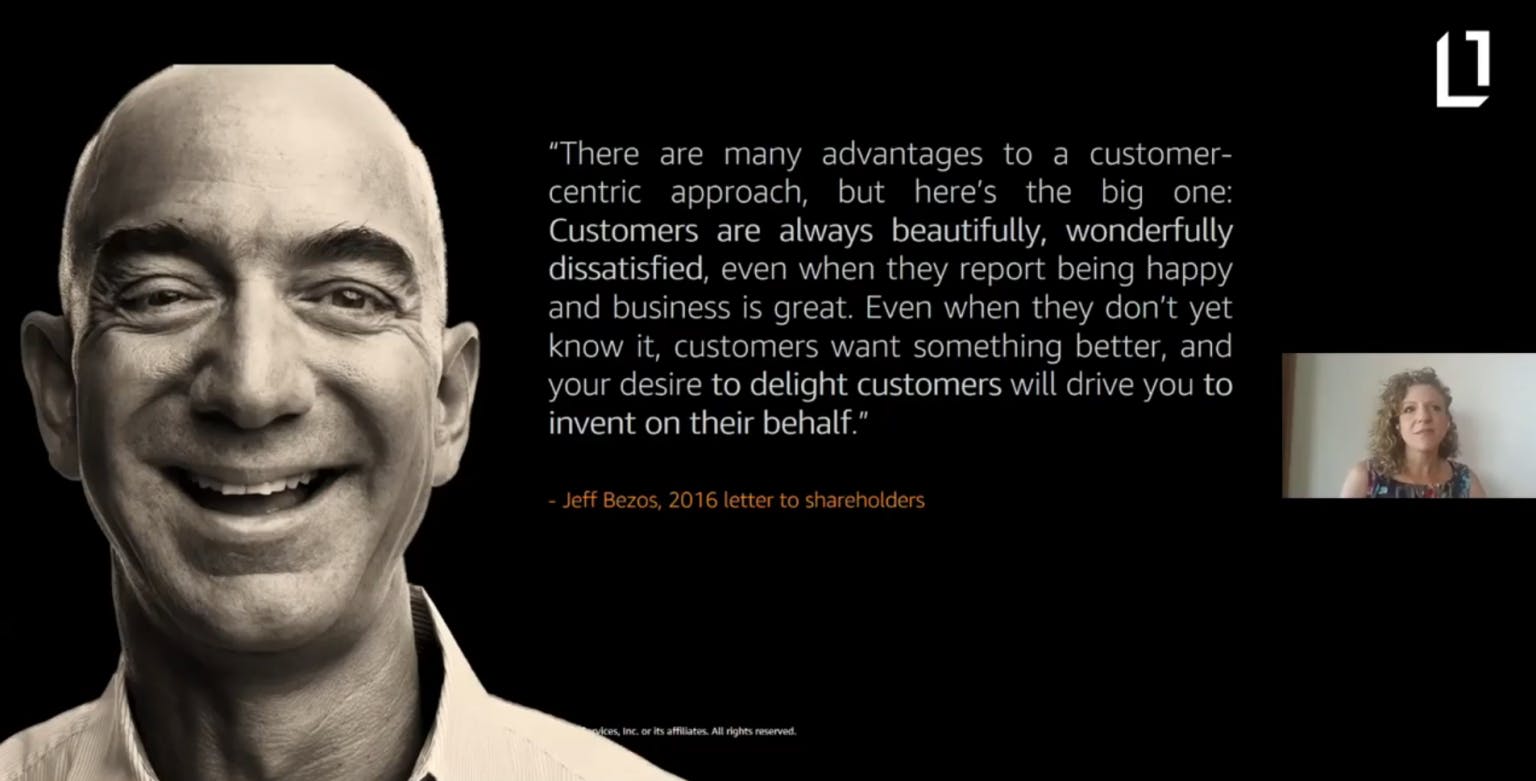Within our Lidr culture, our model is based on: people-business-tech, in that order, because a good technology leader puts people first, thinks in business and uses technology to achieve results.
We have embraced the AWS culture to think in the customer first, create disruptive ideas with our team, and innovate backwards.
A couple of months ago, we hosted a workshop with AWS in order to show to our Lidr community how Amazon always starts with the customer, and work backwards from their needs to build artefacts that allow them to validate the proposal in the market.
This experience brought us a lot of learnings, understanding that there are many different ways to do innovation and many approaches you can follow, but the business modeling and brainstorming sessions are important to get great ideas from anyone on the team. As well as involving the technical team to establish multi-term strategies to achieve the vision of the idea, no matter how disruptive it may be.

So, why is Business modeling so important for the global strategy?
Many startups start the innovation journey from a great idea, although they do not know if it will work as they expect prior to reaching the market. At that point, could be not enough market, or enough need in order to pay or even could be no real interest in your approach to solving the problem.
When there is an idea for a product, the important thing is to identify what is the key factor of the entire business model, understand which is the function and the differentiating element that will have the most impact on the life’s customer and thus, build a product vision around this element to quickly create an MVP that allows you to iterate, learn and improve.
That’s why in the Business Modelling sessions and Innovation workshops is very important to have diversity in the teams even foster interest in innovation across the whole company in order to provide the ownership to bring creative ideas to the table, and empower everyone to participate in the development of those game-changing ideas iteratively.
We at Lidr also apply this Business Modeling. At the beginning, we had a first experience in the market through researching and brainstorming with our team, where we identified that one of the main problems of startups is the lack of middle management and leaders in tech, the lack of appropriate training for those people who aspire to be leaders to enhance the startup ecosystem.
Thus, we created our first delivery to the market, #7daysCTOChallenge, where we iterated, received feedback and 7 months later we created Ignite Mentoring Program, today in our third edition, but we do not stop iterating, asking for feedback, learning and improving to deliver innovative customer-focused products.
What’s the role played by software engineers in innovation?
Having technical people within innovation workshops allows for a multi-step strategy to reach the vision, no matter how disruptive it may be.
One problem with innovation workshops is that there is often a big gap between the limitless ideas and the implementation that comes afterwards. Sometimes Innovation goes out of context because the idea is very inspirational but there isn’t technical feasibility.
Actively involving tech leaders in Business Modeling and innovation processes is vital to defining a feasible yet-innovative future of the company. Someone who masters technology can reduce that gap between illusion and reality. His expertise in technical projects will contribute to and assess the technical viability, providing better estimations of time, cost and complexity of the solutions.
Furthermore, with their expertise at the edge of technology and their exposure to the latest technological trends, these engineers can bring a fresh perspective to the discussion and inspire innovative use cases that could be overlooked by non-tech-savvy participants.
Lidr is on a mission to break down the business and tech barrier and these Business Modeling Sessions help to bring these business areas together. That’s why we do these kind of workshops in collaboration with AWS.
✋ If you want to know all the details of the first edition and know the dates of subsequent editions to put it into practice with us, keep reading!
But first, let’s dive deep into the innovation culture at AWS, told by Andres Hernandez, Startups Solutions Architect @ AWS and an active member of our Lidr community.
AWS Works Backwards with the Startups community
Innovation is the heart of Amazon. We regularly disrupt ourselves – and through our AWS platform, we enable many startups to become industry unicorns and reinvent their markets, think of Netflix, Airbnb, Spotify, all running on AWS.
As we have grown, we have striven to ensure innovation continues to thrive at Amazon. We obsess over our customers and work backwards from their needs, think big and long term in how to meet those needs, and we execute quickly. We try to be right, but we’re happy to be misunderstood, and when we fail, we fail fast.
To do this, we rely on 4 pillars:
It all starts when we hire, we focus on cultural match. Amazonians are builders and innovators who retain a “Day 1” attitude, with speed and agility to build delightful products and services, we empathize with customers and invent on their behalf.
Each Amazonian is a true leader, we encourage our people to generate disruptive ideas across organizations, since speed matters in business, we empower them to build fast.
Many decisions and actions are reversible, those do not need extensive study, and we value calculated risk-taking. Based on the context and situation, Amazonians decide whether to act immediately (bias for action) or to obtain additional information (dive deep). This decision should be based on many factors, including the impact to the customer and whether or not the decision is reversible. We have an analogy to remind us of this: “One-way door vs 2-ways door”. We are stubborn on the vision, but flexible on the details.
Moreover, we do know that many times success can come as a former failure fallout, and as said earlier, we are encouraged to fail fast. Embracing failure is a multi-faceted concept. It involves institutional acceptance that not all products or projects will succeed. Within Amazon, there is a general sense that if your team is constantly succeeding and exceeding against every goal, this is reflective of a lack of ambition. If one truly sets ambitious goals, it is improbable all will be met. Failure is also relative, as an example, while the Fire phone did not perform well, key learnings were applied to new initiatives, we re-associated technology eventually supporting Echo devices.
We also ensure our organization supports innovation rather than stifling it. We decentralize authority and empower our leaders. We appoint Single-Threaded Owners and build small autonomous, cross-functional teams to identify, rationalize, and achieve business and technology objectives, we called those 2-pizza teams; if they are still hungry after two pizzas, the team should split.
We have technology architecture to empower our innovators – we build self-service tools whenever we can and the cloud-based AWS platform ensures we have the agility to build quickly, scale fast, and minimize the cost of failure. Re-combining technology as building blocks frequently inspires new business models, we want our people to focus on creating secret sauces, instead of reinventing the wheel and spending their time with undifferentiated heavy-lifting.
Finally, we deploy specific mechanisms that turn ideas into meaningful innovations – these are processes and mental models that help turn good intentions into action, and facilitate high-velocity decision-making and execution.
Lidr and AWS partnering to foster startups innovation processes
We have recently conducted an intensive one-day interactive session with Lidr’s startups community, leveraging one of these mechanisms: the Working Backwards Workshop, which aims to help diverse teams to defining a new product, service, or experience, and then rapidly bring that solution to life and to market. This highly collaborative engagement is inspired by the same customer-centric methods used by Amazon to develop breakthrough innovations our customers love, such as Amazon Prime, Amazon Kindle, AWS, Amazon Echo and Alexa, and Amazon Go.
We start by identifying an end-customer, and their specific problem or opportunity. Again, the goal is to have an exercise that allows empathizing with the customer feelings and only then define a new solution that meets that customer’s most pressing need.
Together, we bring the idea to life by writing a future Press Release and Frequently Asked Questions document (PR-FAQ), this document is meant to imagine what the customer would feel about the product once launched, with the objective to identify beforehand, what is the most special element that would bring value for the customer and improve their life, such element will be the center of the vision we said above we will be stubborn on, and build prototypes as needed being flexible on the details to further validate and refine the concept. When startups are ready, we then use the AWS platform to take the solution to scale.
If you want to know the next Aws events, subscribe to our Lidr newsletter and keep up to date with their latest workshops!

